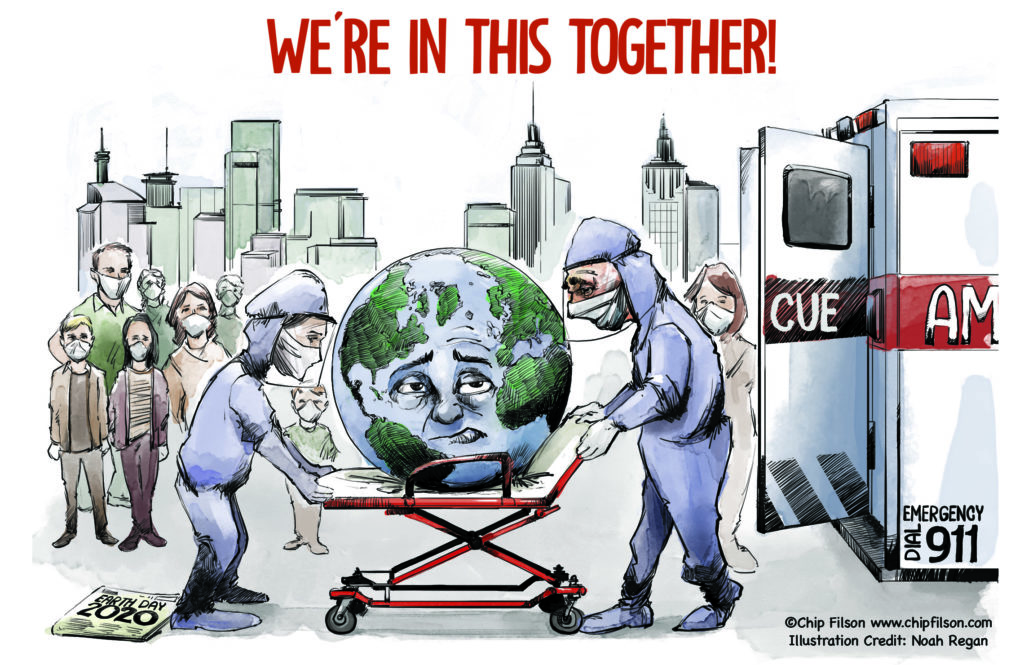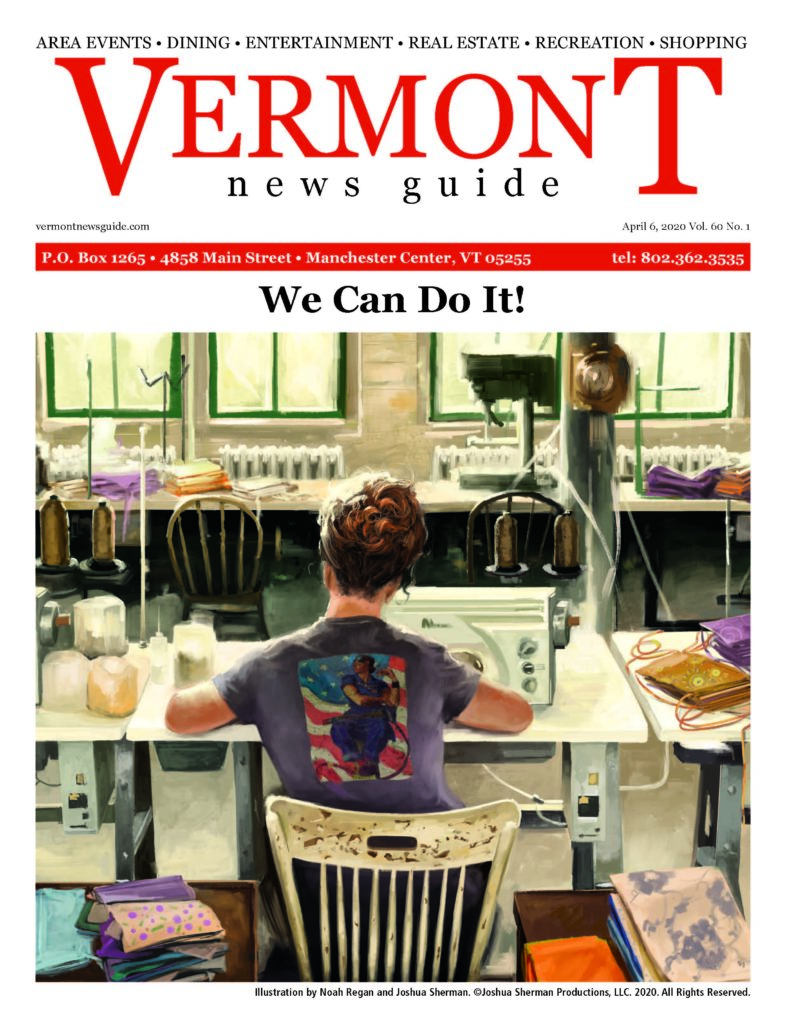- I started life with nothing and still have most of it.
- In our house we have done so much walking that the dog has lost ten pounds.
- The stay-at-home orders are going to accelerate the digital revolution in society by at least ten years.
- The reason for my hope is the re-creation of an overriding common purpose.
- “We shall not cease from exploration, and the end of all our exploring will be to arrive where we started and know the place for the first time.” – T. S. Eliot
Dual Pandemics

About this Cartoon
On Monday I showed a Norman Rockwell inspired illustration We Can Do It from the Vermont News Guide.
I contacted the artist, Noah Regan, to ask if he might create images that show credit unions’ unique roles during this pandemic crisis.
He said yes. Believing that a picture is worth at least a thousand words, we intend to bring you periodic illustrations capturing the themes of the times we are going through.
Noah is accomplished in many different artistic genres: cartoons, portraits, illustrations and graphics. He lives in Iowa and is a member of Veridian Credit Union. His interests outside of art include cycling, listening to podcasts and audiobooks, writing in the third person, and discovering music (both old and new) on Spotify. More of Noah’s work can be found at ArtHouse Illustrations: https://www.arthouseill.com/about
We are seeking photos of credit unions doing the right things for members to inform Noah’s compositions. Please email your ideas to me.
Art for Our Time
A combination of Norman Rockwell and Rosie the Riveter.
Illustration by Noah Regan and Joshua Sherman as it appeared in the Vermont News Guide (vtnewsguide.com)
(C) Joshua Sherman Productions, LLC. 2020. All Rights Reserved.
For the story behind this illustration, the business pivot of Vermont Glove to making medical masks, click: https://vermontnews-guide.com/recent-emails/
A Perspective for Our Time?
Singing Affirming Community
The TV is filled with instances of persons singing during the pandemic. An opera tenor from his balcony in Italy; students from their dorms in Princeton NJ. Clapping, pot banging and yes singing, on the streets of New York for health care workers.
Singing comforts and transcends the moment. It creates and affirms the communities we all belong to. And it can inspire.
Down In the River
For Mennonites, music is integral to their religious services. Their a cappella four-part harmonies of familiar tunes effortlessly engage the listener’s full attention.
An example is this three-minute video recording of Down In the River.
The five verses invite first sisters (women singers) followed by brothers, mothers, fathers and finally all “down in the river” to pray. The swelling chorus walking to the stage adding voices and parts with each verse, repeats the same question. The white, plain headdress on singers and audience reinforces the simplicity of the music’s message.
Going IN the River
But how does going down IN the river relate to now? When uncertainty causes each person’s fate to be more contingent than ever, deeper questions of meaning arise. This reflective instinct is heightened when walking to water-streams, ponds, rivers, ocean fronts. There is a double meaning in the “reflecting pool” in front of Lincoln’s monument in Washington D.C.
In the opening pages of Moby Dick, Ishmael declares, “Yes, meditation and water are wedded forever.” Is covid-19 this generation’s white whale?
For me, this gentle folk tune invites us (show me the way) to go down IN the river and asks: “Who shall wear the starry crown” in this moment?
Why Do We Walk Toward Danger
A college friend who became a doctor and author (pen name Samuel Shem) sent a message about his recent experiences at the NYU Grossman Medical Center. He was lecturing there on March 4th, caught the virus, and transmitted it to his wife. Both have now recovered.
Being on the front lines prompted him to reflect on why health service workers willingly take this risk. Day in and day out. Part of his thoughts follow:
“Why do we walk toward danger?” Treating hundreds of patients afflicted by this high-virulence pathogen is scary. Our contact with it can kill us. And we risk infecting our loved ones at home. . .
What brings out our best in horrific times is our connection with each other, our “being with.” The danger mobilizes our shared relationships and focuses our skill. In any of these good connections, we feel more energy, value and understanding of each other, more empowered to act, and a desire to connect again. We come out of these encounters more ready to “do the right thing” for patients, our team, and our selves. We might have felt that we could not go on for another minute, but then—in the connecting—our resilience and energy returns! Good connection makes good care. . .
This is what keeps us going through hard times like these. Simply put, it’s a shift to the “We.” Working together under this pressure brings forth the “we”—and then the “we” strengthens the connection.
Or as Navy Federal Credit Union headlined their annual report several decades ago: “Our strength is our union.”
OIG Report on The FDIC’s Readiness for Crisis
Completed in 2019, the FDIC’s Office of Inspector General (OIG) reissued this report yesterday to assist in responding to the current crisis.
There are two takeaways that could help the credit union system.
The first describes how the FDIC performs self-evaluations of its performance in past crises. This process is summarized in the following paragraph for the Great Recession. To my knowledge, NCUA has never conducted any study of its actions in this event.
Two current board members were directly involved, at different times, in the implementation of the Corporate Resolution plan begun in 2009. The current surplus of over $6 billion from the five corporate liquidations, versus NCUA’s projected costs of $13-$16 billion, suggest the urgency of understanding how such a catastrophic supervisory misjudgment could have occurred.
Below is how the FDIC’s evaluated its role:
“Since its inception in 1933, the FDIC has responded to several financial crises in the banking system. In 2012 and 2017, the FDIC completed two Agency-wide studies of its response to the financial crisis of 2008-2013. These studies identified challenges that the FDIC experienced and addressed during the prior financial crisis, such as those related to staffing, contracting, and information technology. The studies also identified lessons learned and recommendations, some of which the FDIC has incorporated or planned to incorporate into its operations and crisis readiness planning. Such operational improvements have helped the FDIC continue to enhance its readiness for crises impacting insured depository institutions.”
A second benefit of the OIG report is the identification of best practices in crisis management. It evaluated the FDIC’s capability on each of these. These seven practices are listed as follows:
“The OIG identified that guidance established by the Department of Homeland Security and Federal Emergency Management Agency on planning for crisis events could be used as best practices by the FDIC. Additionally, best practices from non-Federal sources reinforce the concepts articulated in Federal best practices.
Our review of these best practices identified seven important elements of a crisis readiness framework that are relevant to the FDIC – (i) Policy and Procedures; (ii) Plans; (iii) Training; (iv) Exercises; (v) Lessons Learned; (vi) Maintenance; and (vii) Assessment and Reporting.”
The 73-page, reissued OIG report is available on the FDIC OIG website.
A CEO’s View of the Current Moment
From the Field: What is a Credit Union?
“A Credit Union is a place to do your banking – we do loans, have checking and savings accounts, credit cards, mortgages, and other banking items. We are a not-for-profit cooperative financial institution, and operate like a bank except we don’t issue stock on Wall St. Since we don’t have to pay stockholders, we can use our income to provide lower loan rates, higher deposit rates, and do other things like reinvest in our community, give to charities, and keep our fees low for services. At NET Credit Union, we don’t have customers, we have members. Members have voting rights as to how the credit union operates. Our board of directors are volunteers – they don’t’ get paid to sit on the board. When you bank with NET, your money stays right here, local. There’s so much more you get when you bank on NET.”
A Sunday Meditation for Our Time
With thanks to Mark Willey, organist choirmaster at Georgetown Presbyterian Church, Washington D.C.:
Martin Rinckart walked quickly down the filthy side street that led to his house, distracted only briefly by a hungry mob fighting over the body of a scrawny and very dead cat. He knew them all, had ministered to them, buried their children, and fed them what he could spare from his own meager rations.
Today though, he carried nothing but an idea, a poem that had come to him while he was conducting one of ten funerals he had conducted that day.a He needed to write it down before it was forgotten.
Opening his front door, he rushed to his small desk and picked up a goose quill pen. Dipping it into the well, his mind wandering over the events of the past year, as the tip slowly filled with iron gall ink.
He could see their faces and hear their cries of anguish. The weeping parents burying their only child, the grieving young widow, sick herself with only days to live. They were almost too numerous to count, but as the town’s only living minister and one of just three surviving members of the town council, it was his job to count. In that year alone, he’d buried over four thousand souls, their lives cut down by the Black Plague, but this was just the latest pestilence.
Ever since his appointment in 1617 as Archdeacon of Eilenburg in Saxony, he’d never known peace, or plenty. The skirmishes between the various Protestant and Catholic states had metastasized into an all-out war in 1618; a war that killed millions. Poverty, sickness, hunger, and death were ever present for Martin, and his life was devoted in service to those who suffered.
Lifting the pen from the well, he set its tip on the paper. The familiar scratching sound of its strokes quickened as the letters formed words, flowing into lines of poetry:
Nun danket alle Gott Now thank we all our God,
mit Herzen, Mund und Händen, with heart and hands and voices,
der große Dinge tut Who wondrous things has done,
an uns und allen Enden, in Whom this world rejoices;
der uns von Mutterleib Who from our mothers’ arms
und Kindesbeinen an has blessed us on our way
unzählig viel zu gut With countless gifts of love,
bis hierher hat getan. and still is ours today.
https://www.youtube.com/watch?v=skdWLWF6Ttw
It’s hard to imagine this hymn emerging from such a dark time: a plague, and famine in the middle of a thirty-year long war. Somehow, between all the burials, feeding the hungry, caring for the sick, and ministering to as many people as he could, Martin Rinckart found time, and a spirit of thankfulness to write these words.
Writing them didn’t put an end to the plague, or bring peace to Europe, but Martin seems to have discovered what a spate of recent studies are confirming: Gratitude is good for our minds and bodies.
Could we, would we write words like these today? The words of this hymn of thankfulness flow from Martin’s time to ours, to inspire us to live with a spirit of gratitude in the face of sickness, even the threat of death, and how to focus our energy on service, rather than fear. The world needs more Martins. I want to be one. Don’t you?

